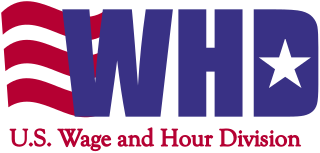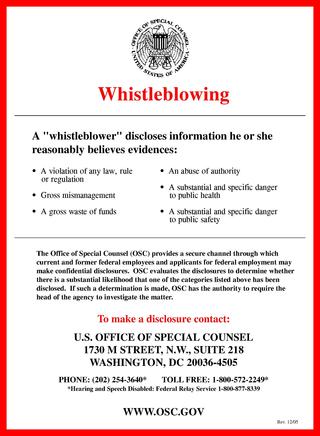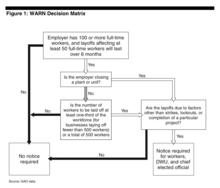State and local laws
In addition to the WARN Act, which is a federal law, several states have enacted similar acts that require advance notice or severance payments to employees facing job loss from a mass layoff or plant closing. For example, California requires advance notice for plant closings, layoffs, and relocations of 50 or more employees regardless of percentage of workforce, that is, without the federal "one-third" rule for mass layoffs of fewer than 500 employees. Also, the California law applies to employers with 75 or more employees, counting both full-time and part-time employees. [5]
The following states and localities have passed state or local WARN Acts.
- California
- Hawaii
- Illinois
- Iowa
- Maine
- Massachusetts
- Michigan (voluntary)
- Minnesota (voluntary)
- New Hampshire
- New Jersey
- New York
- Tennessee
- Wisconsin
- City of Philadelphia
A number of states have laws that create ancillary duties at the time of job layoffs; but which generally do not seek to mandate advance notice or severance payments to workers in a manner similar to the federal WARN Act, other states' statutes, or the laws found in Canadian or European jurisdictions. Maryland, Missouri, Oklahoma, and Pennsylvania have statutes that require filing certain disclosure statements when businesses are the takeover targets of other corporations or when businesses are being dissolved. The statements generally require disclosure of plans to close facilities in the state. Connecticut requires employers to maintain health insurance for a certain period of time following the relocation of operations. Kansas requires the notification of state officials when businesses plan to close facilities or significantly cut production in select industries. Maryland, Michigan and Minnesota have statutes that ask employers to voluntarily provide advance notice to workers in the event of mass layoffs; however these states to not require compliance with the state's statute. Montana and Nevada statutes require advance notice to certain public employees facing layoff. Oregon and Tennessee have laws that simply implement the federal WARN Act. South Carolina requires that employers provide the same notice to laid off workers that workers are contractually required to provide to the employer when leaving their employment. Ohio requires that state unemployment agency officials be notified several days in advance of mass layoffs.
- New York State
The New York State Worker Adjustment and Retraining Notification (WARN) Act requires businesses to give early warning of closing and layoffs. The law is stricter on employers when compared to the federal WARN Act. It applies to companies with 50 or more employees (unlike 100 for the federal law) where either 25 (50 for the federal law) or more workers are affected, if that number makes up at least 33% of the workers on that site. NY WARN Act requires a 90-day notice from the employer, unlike the federal Act that requires a 60-day notice. [6]
The Occupational Safety and Health Administration is a large regulatory agency of the United States Department of Labor that originally had federal visitorial powers to inspect and examine workplaces. The United States Congress established the agency under the Occupational Safety and Health Act, which President Richard M. Nixon signed into law on December 29, 1970. OSHA's mission is to "assure safe and healthy working conditions for working men and women by setting and enforcing standards and by providing training, outreach, education, and assistance." The agency is also charged with enforcing a variety of whistleblower statutes and regulations. OSHA's workplace safety inspections have been shown to reduce injury rates and injury costs without adverse effects on employment, sales, credit ratings, or firm survival.

The Occupational Safety and Health Act of 1970 is a US labor law governing the federal law of occupational health and safety in the private sector and federal government in the United States. It was enacted by Congress in 1970 and was signed by President Richard Nixon on December 29, 1970. Its main goal is to ensure that employers provide employees with an environment free from recognized hazards, such as exposure to toxic chemicals, excessive noise levels, mechanical dangers, heat or cold stress, or unsanitary conditions. The Act created the Occupational Safety and Health Administration (OSHA) and the National Institute for Occupational Safety and Health (NIOSH).
In United States labor law, at-will employment is an employer's ability to dismiss an employee for any reason, and without warning, as long as the reason is not illegal. When an employee is acknowledged as being hired "at will", courts deny the employee any claim for loss resulting from the dismissal. The rule is justified by its proponents on the basis that an employee may be similarly entitled to leave their job without reason or warning. The practice is seen as unjust by those who view the employment relationship as characterized by inequality of bargaining power.
A layoff or downsizing is the temporary suspension or permanent termination of employment of an employee or, more commonly, a group of employees for business reasons, such as personnel management or downsizing an organization. Originally, layoff referred exclusively to a temporary interruption in work, or employment but this has evolved to a permanent elimination of a position in both British and US English, requiring the addition of "temporary" to specify the original meaning of the word. A layoff is not to be confused with wrongful termination. Laid off workers or displaced workers are workers who have lost or left their jobs because their employer has closed or moved, there was insufficient work for them to do, or their position or shift was abolished. Downsizing in a company is defined to involve the reduction of employees in a workforce. Downsizing in companies became a popular practice in the 1980s and early 1990s as it was seen as a way to deliver better shareholder value as it helps to reduce the costs of employers. Research on downsizing in the US, UK, and Japan suggests that downsizing is being regarded by management as one of the preferred routes to help declining organizations, cutting unnecessary costs, and improve organizational performance. Usually a layoff occurs as a cost-cutting measure. A study of 391 downsizing announcements of the S&P 100 firms for the period 1990-2006 found, that layoff announcements resulted in substantial increase in the companies’ stock prices, and that the gain was larger, when the company had prior layoffs. The authors suggested, that the stock price manipulation alone creates a sufficient motivation for publicly-traded corporations to adopt the practice of regular layoffs.
In labor law, a union shop, also known as a post-entry closed shop, is a form of a union security clause. Under this, the employer agrees to either only hire labor union members or to require that any new employees who are not already union members become members within a certain amount of time. Use of the union shop varies widely from nation to nation, depending on the level of protection given trade unions in general.

The Consolidated Omnibus Budget Reconciliation Act of 1985 (COBRA) is a law passed by the U.S. Congress on a reconciliation basis and signed by President Ronald Reagan that, among other things, mandates an insurance program which gives some employees the ability to continue health insurance coverage after leaving employment. COBRA includes amendments to the Employee Retirement Income Security Act of 1974 (ERISA). The law deals with a great variety of subjects, such as tobacco price supports, railroads, private pension plans, emergency department treatment, disability insurance, and the postal service, but it is perhaps best known for Title X, which amends the Internal Revenue Code and the Public Health Service Act to deny income tax deductions to employers for contributions to a group health plan unless such plan meets certain continuing coverage requirements. The violation for failing to meet those criteria was subsequently changed to an excise tax.

The rights and duties for employees, labor unions, and employers are set by labor law in the United States. Labor law's basic aim is to remedy the "inequality of bargaining power" between employees and employers, especially employers "organized in the corporate or other forms of ownership association". Over the 20th century, federal law created minimum social and economic rights, and encouraged state laws to go beyond the minimum to favor employees. The Fair Labor Standards Act of 1938 requires a federal minimum wage, currently $7.25 but higher in 29 states and D.C., and discourages working weeks over 40 hours through time-and-a-half overtime pay. There are no federal laws, and few state laws, requiring paid holidays or paid family leave. The Family and Medical Leave Act of 1993 creates a limited right to 12 weeks of unpaid leave in larger employers. There is no automatic right to an occupational pension beyond federally guaranteed Social Security, but the Employee Retirement Income Security Act of 1974 requires standards of prudent management and good governance if employers agree to provide pensions, health plans or other benefits. The Occupational Safety and Health Act of 1970 requires employees have a safe system of work.

The Age Discrimination in Employment Act of 1967 is a United States labor law that forbids employment discrimination against anyone, at least 40 years of age, in the United States. In 1967, the bill was signed into law by President Lyndon B. Johnson. The ADEA prevents age discrimination and provides equal employment opportunity under the conditions that were not explicitly covered in Title VII of the Civil Rights Act of 1964. The act also applies to the standards for pensions and benefits provided by employers, and requires that information concerning the needs of older workers be provided to the general public.
In contract law, a non-compete clause, restrictive covenant, or covenant not to compete (CNC), is a clause under which one party agrees not to enter into or start a similar profession or trade in competition against another party. Some courts refer to these as "restrictive covenants". As a contract provision, a CNC is bound by traditional contract requirements including the consideration doctrine.

The Uniformed Services Employment and Reemployment Rights Act of 1994 was passed by U.S. Congress and signed into law by U.S. President Bill Clinton on October 13, 1994 to protect the civilian employment of active and reserve military personnel in the United States called to active duty. The law applies to all United States uniformed services and their respective reserve components.

E-Verify is a United States Department of Homeland Security (DHS) website that allows businesses to determine the eligibility of their employees, both U.S. and foreign citizens, to work in the United States. The site was originally established in 1996 as the Basic Pilot Program to prevent companies from hiring people who had violated immigration laws and entered the United States illegally. In August 2007, DHS started requiring all federal contractors and vendors to use E-Verify. The Internet-based program is free and maintained by the United States government. While federal law does not mandate use of E-Verify for non-federal employees, some states have mandated use of E-Verify or similar programs, while others have discouraged the program.

In California, the Employment Development Department (EDD) is a department of the state government that administers Unemployment Insurance (UI), Disability Insurance (DI), and Paid Family Leave (PFL) programs. The department also provides employment service programs and collects the state's labor market information and employment data. EDD is one of California's three major taxation agencies, alongside California Department of Tax and Fee Administration and the Franchise Tax Board. In addition to collecting unemployment insurance taxes, the department administers the reporting, collection, and enforcement of the state's personal income taxes.
The Congressional Accountability Act of 1995 (CAA), the first piece of legislation passed by the 104th United States Congress, applied several civil rights, labor, and workplace safety and health laws to the U.S. Congress and its associated agencies, requiring them to follow many of the same employment and workplace safety laws applied to businesses and the federal government. Previously, agencies in the legislative branch had been exempt from these laws. The act also established a dispute resolution procedure as an alternative to filing claims in federal court. The act is administered and enforced by the Office of Congressional Workplace Rights.

The Fair Labor Standards Act of 1938 29 U.S.C. § 203 (FLSA) is a United States labor law that creates the right to a minimum wage, and "time-and-a-half" overtime pay when people work over forty hours a week. It also prohibits employment of minors in "oppressive child labor". It applies to employees engaged in interstate commerce or employed by an enterprise engaged in commerce or in the production of goods for commerce, unless the employer can claim an exemption from coverage. The Act was enacted by the 75th Congress and signed into law by President Franklin D. Roosevelt in 1938.

The California Labor Code, more formally known as "the Labor Code", is a collection of civil law statutes for the State of California. The code is made up of statutes which govern the general obligations and rights of persons within the jurisdiction of the State of California. The stated goal of the Department of Industrial Relations is to promote and develop the welfare of the wage earners of California, to improve their working conditions and to advance their opportunities for profitable employment."

The Wage and Hour Division (WHD) of the United States Department of Labor is the federal office responsible for enforcing federal labor laws. The Division was formed with the enactment of the Fair Labor Standards Act of 1938. The Wage and Hour mission is to promote and achieve compliance with labor standards to protect and enhance the welfare of the Nation's workforce. WHD protects over 144 million workers in more than 9.8 million establishments throughout the United States and its territories. The Wage and Hour Division enforces over 13 laws, most notably the Fair Labor Standards Act and the Family Medical Leave Act. In FY18, WHD recovered $304,000,000 in back wages for over 240,000 workers and followed up FY19, with a record-breaking $322,000,000 for over 300,000 workers.

A whistleblower is a person who exposes any kind of information or activity that is deemed illegal, unethical, or not correct within an organization that is either private or public. The Whistleblower Protection Act was made into federal law in the United States in 1989.
The elaws Advisors are a set of interactive, online tools developed by the U.S. Department of Labor to help employers and employees learn more about their rights and responsibilities under numerous Federal employment laws. They address some of the nation's most widely applicable employment laws, offering easy-to-understand information on areas such as:

The Fair Work Act 2009(Cth) is an Act of the Parliament of Australia, passed by the Rudd government to reform the industrial relations system of Australia. It replaced the Howard government's WorkChoices legislation, it established Fair Work Australia, later renamed the Fair Work Commission.

Local 217, Hotel & Restaurant Employees Union v MHM Inc, 976 F.2d 805 (1992) is a US labor law case, concerning the scope of labor rights in the United States.










